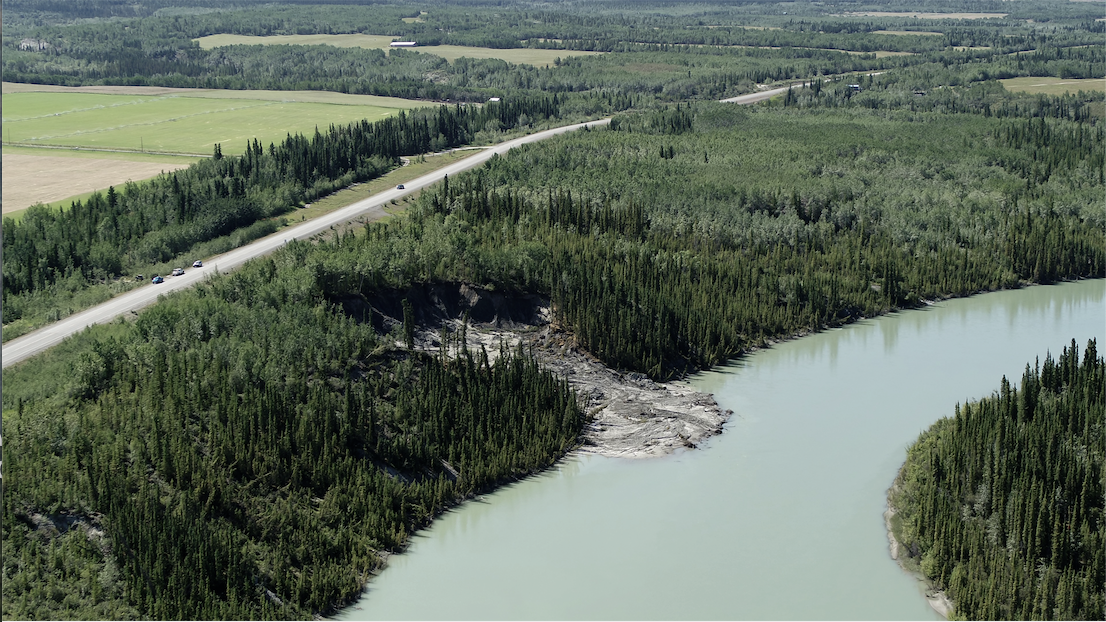 Permafrost-related geohazards have important implications for transportation infrastructure, especially in the face of a changing climate. As permafrost thaws, landslides (retrogressive thaw slumps) and other geohazards can occur along roads, highways, or airstrips.
Permafrost-related geohazards have important implications for transportation infrastructure, especially in the face of a changing climate. As permafrost thaws, landslides (retrogressive thaw slumps) and other geohazards can occur along roads, highways, or airstrips.
Much of the transportation infrastructure in the North is now impacted, and in the most dramatic cases, permafrost related hazards can damage infrastructure so that on-site traffic is completely disrupted, communities are isolated, and damaged sections can present an immediate and life-threatening danger to users. To help mitigate the risk of permafrost-related geohazards, this project has worked towards developing an alarm warning system to notify infrastructure operators of an elevated risk of geohazard occurrence.
Alarm systems have been developed and installed at airstrips at three Nunavik airports (Salluit, Tasiujaq and Inukjuak), and prototypes have been developed for retrogressive thaw slumps along the Alaska and Dempster Highways (km 1456 along the Alaska Highway and km 116 along the Dempster Highway).
These alarm systems will lead to safer, more reliable transportation infrastructure, and allow infrastructure operators to act quickly in the event of a geohazard occurrence. These alarm systems have the potential to be applied to various types of geohazards affecting transportation networks across the country.
Working in partnership with researchers at Université Laval and Université de Montréal, we have developed an early-warning alarm system to warn transport infrastructure operators of impending risks to infrastructure including roads, highways, and airstrips. As the climate warms, and precipitation patters change, permafrost thaw-related geohazards are increasingly likely, which could lead to dangerous conditions and the possibility of isolating communities.
To develop these alarm systems, site specific algorithms have been developed to trigger a warning signal based on specific conditions that suggest impending hazard risks. To develop these algorithms, in depth site studies have been conducted at each of the five sites. These algorithms have been developed, and the alarm systems have been deployed at the Nunavik airport sites (Salluit, Tasiujaq and Inukjuak), where site studies were already advanced. At the Yukon sites, an algorithm has been developed and the hardware has been installed at km 1456 of the Alaska Highway outside of Whitehorse. A working prototype will be in place at this site in spring 2022. For the Dempster Highway site (km 116 at Chapman Lake), the remote nature of the location requires satellite connection to in-situ sensors, creating an additional layer of complexities. A working alarm system is expected by summer 2023.
Dr. Fabrice Calmels, Research Chair in Permafrost & Geoscience, YukonU Research Centre
Dr. Michel Allard, Professor Emeritus, Dept. of Geography, Université Laval
Dr. Daniel Fortier, Professor, Dept. of Geography, Université de Montréal
Frances Amyot, Permafrost Researcher, Permafrost & Geoscience, YukonU Research Centre
Emmanuel L’Hérault, Research Associate, Université Laval
Michel Sliger, Research Associate, Université de Montréal
Louis Philippe Roy, Research Professional, Permafrost & Geoscience, YukonU Research Centre
Cyrielle Laurent, GIS Technician, Permafrost & Geoscience, YukonU Research Centre
Cathy Koot, Project Officer, YukonU Research Centre
Sarah Gauthier, PhD Student, Université Laval
Transport Canada Northern Transportation Adaptation Initiative
Highways and Public Works, Transportation Engineering Branch, Government of Yukon
ArcticNet
Crown Indigenous Relations and Northern Affairs Canada (CIRNAC)
Climate Change Preparedness in the North (CCPN)
Yukon Geological Survey
YukonU Research Centre
Centre d’études Nordiques
Laval University
Yukon Government
Ministère des Transports du Québec